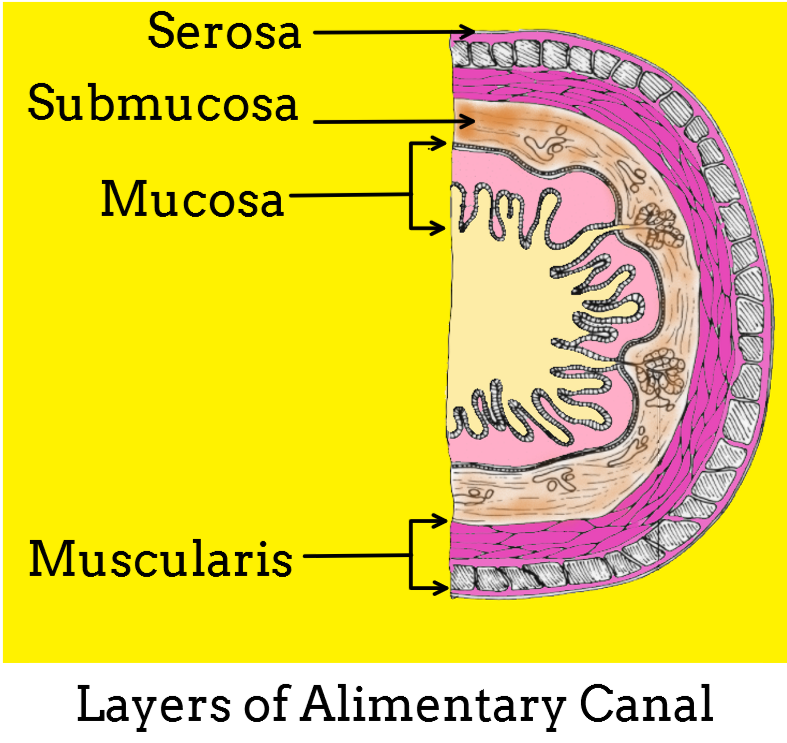
What are the basic layers of the wall of the alimentary canal?
Answer
582.6k+ views
Hint: The alimentary canal is a long passage running from the mouth to the anus including all the organs of the digestive system in humans and other animals.
Complete answer:
Throughout its length, the alimentary tract is composed of the same four tissue layers: mucosa, submucosa, muscularis, and serosa.
-The mucosa is the innermost layer. It secretes a large amount of mucus and therefore is known as mucus membrane. The mucosal layer is lined by stratified squamous epithelium in the mouth and esophagus, and by columnar cells in the stomach and intestine. It lies in direct contact with ingested food, the lamina propria (connective tissue layer), and the muscularis mucosa, a thin smooth muscle layer.
-The submucosa lies externally to the mucosa. It is a broad layer of dense connective tissue; it connects the overlying mucosa to the underlying muscularis. It includes blood and lymphatic vessels, and a scattering of submucosal glands that release digestive secretions.
-The muscularis layer of the gastrointestinal tract is made up of smooth muscle arranged in an inner circular layer and an outer longitudinal layer. They cause strong peristaltic contraction and help in the propulsive movement of food, mixing of digestive juices, and digestion.
-The serosa is the outermost protective layer lying externally to the muscularis. It is present only in the stomach and intestinal part. The mouth, pharynx, and esophagus possess another protective dense sheath of collagen fibers. It is called the adventitia.

Note:
-The mucosal layer is rich in goblet cells which secrete mucus. In the small intestine, the mucosa is modified to form numerous small projections known as ‘Villi’. They increase the surface area of the intestine for absorption.
-The mucosa of duodenum consists of Brunner's glands that secrete bicarbonate ions and mucus.
-The Myenteric or the Auerbach's plexus located between the two layers of muscularis maintains the peristaltic movement of the intestine.
Complete answer:
Throughout its length, the alimentary tract is composed of the same four tissue layers: mucosa, submucosa, muscularis, and serosa.
-The mucosa is the innermost layer. It secretes a large amount of mucus and therefore is known as mucus membrane. The mucosal layer is lined by stratified squamous epithelium in the mouth and esophagus, and by columnar cells in the stomach and intestine. It lies in direct contact with ingested food, the lamina propria (connective tissue layer), and the muscularis mucosa, a thin smooth muscle layer.
-The submucosa lies externally to the mucosa. It is a broad layer of dense connective tissue; it connects the overlying mucosa to the underlying muscularis. It includes blood and lymphatic vessels, and a scattering of submucosal glands that release digestive secretions.
-The muscularis layer of the gastrointestinal tract is made up of smooth muscle arranged in an inner circular layer and an outer longitudinal layer. They cause strong peristaltic contraction and help in the propulsive movement of food, mixing of digestive juices, and digestion.
-The serosa is the outermost protective layer lying externally to the muscularis. It is present only in the stomach and intestinal part. The mouth, pharynx, and esophagus possess another protective dense sheath of collagen fibers. It is called the adventitia.

Note:
-The mucosal layer is rich in goblet cells which secrete mucus. In the small intestine, the mucosa is modified to form numerous small projections known as ‘Villi’. They increase the surface area of the intestine for absorption.
-The mucosa of duodenum consists of Brunner's glands that secrete bicarbonate ions and mucus.
-The Myenteric or the Auerbach's plexus located between the two layers of muscularis maintains the peristaltic movement of the intestine.
Recently Updated Pages
Why are manures considered better than fertilizers class 11 biology CBSE

Find the coordinates of the midpoint of the line segment class 11 maths CBSE

Distinguish between static friction limiting friction class 11 physics CBSE

The Chairman of the constituent Assembly was A Jawaharlal class 11 social science CBSE

The first National Commission on Labour NCL submitted class 11 social science CBSE

Number of all subshell of n + l 7 is A 4 B 5 C 6 D class 11 chemistry CBSE

Trending doubts
10 examples of friction in our daily life

One Metric ton is equal to kg A 10000 B 1000 C 100 class 11 physics CBSE

Difference Between Prokaryotic Cells and Eukaryotic Cells

1 Quintal is equal to a 110 kg b 10 kg c 100kg d 1000 class 11 physics CBSE

State the laws of reflection of light

Explain zero factorial class 11 maths CBSE




